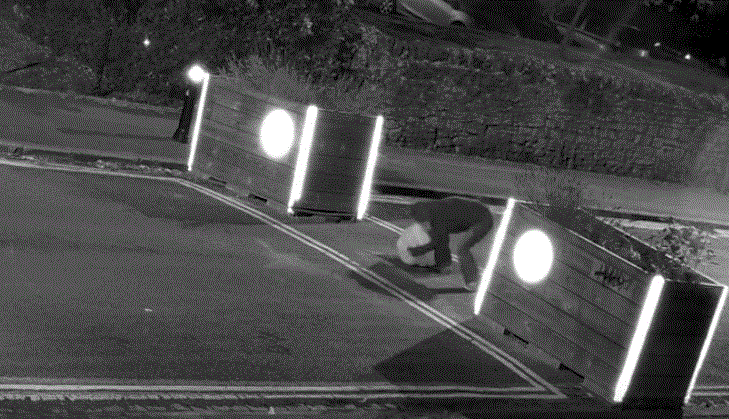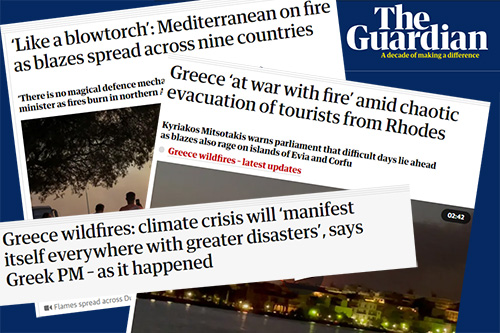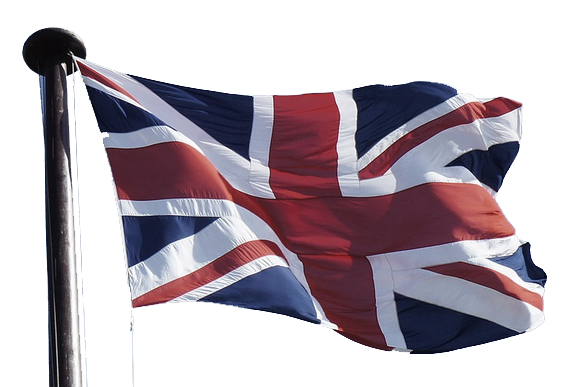|
|
||||
How many solar panels does it take to stop an arsonist?For two weeks the global media circus has been blaming climate change for the fires in Greece. But finally, belatedly we find out it’s arson (again) and not because Europe doesn’t have enough solar panels yet. The way the Guardian reports this, it’s as if arsonists hit Greece every year, but this year was different because of “climate change.” So if your civilization has thrill-seekers running amok, laying waste to land and property, the problem is not law and order, unemployment, or a sense of community, it’s “coal fired power plants”. Can we stop calling them wildfires when they are synthetic? Thanks to NetZeroWatch Most fires in Greece were started ‘by human hand’, government saysHelena Smith in The Guardian Most of the 667 fires that have erupted across Greece in recent weeks were started “by human hand”, the country’s senior climate crisis official has said. Kikilias said that, in certain places, blazes had broken out at numerous points in close proximity at the same time, suggesting the involvement of arsonists intent on spreading fires further. Arsonists are not the problem, children, climate change is: He added: “The difference with other years were the weather conditions. Climate change, which yielded a historic and unprecedented heatwave, is here. It was surprising The Guardian chose to report this given how silly it makes their fixation on blaming climate change look. But they get to mention “climate” six more times, and “hottest on record” twice again. They don’t ask whether their own non-stop hyperbolic reporting of Fires, Fires, Fires, like the rest of the media, encourages the arsonists. They don’t ask where the nation is going wrong, or why this news wasn’t announced earlier. Greek officials surely didn’t need two weeks to put this pattern together. Most of the important factors in wildfires are things climate models can’t predict at all — like wind, rain, and the Pacific Decadal Oscillation. The worst fires are not the ones in the hottest spots on Earth. They aren’t in the Sahara Desert or Death Valley — they’re where the fuel loads are — especially when mixed with a civilization that is losing its way. How to hide $100b storage, transmission lines, battery costs in a dodgy accounting trickThe cost for our whole national $100 billion dollar energy transition apparently rests on a CSIRO report that assumes we’ve already spent the infrastructure money “therefore” future costs after 2030 are almost nothing. It’s like a Nigerian email scam… except that it has fooled our Minister for Energy. You have been selected to win a new national electricity grid, just give us your economy… Chris Bowen, said Minister, thinks wind and solar will reduce the cost of electricity, despite them doing the opposite so far.
There is a circular reasoning here that says we assume it’s worth spending bezillions now because renewables will be cheap after we have spent bezillions. But that’s only true if we assume the bezillions are a sunk cost we’ve already spent. See how this scam works? The bill never comes in. Somewhere someone lost $100 billion dollars and no one at our once hallowed Commonwealth Scientific and Industrial Research Organisation (CSIRO) even noticed. It’s like living in an Escher puzzle where you walk up the endless stairs to renewable heaven but never get there. Why our energy transition needs a price tagClaire Lehmann, The Australian Writing in the Fresh Economic Thinking publication, Aidan Morrison points out that the CSIRO’s claim that renewables are the “cheapest” form of energy rests almost entirely on a misapplication of the “sunk cost” assumption. In many situations, it makes sense to account for sunk costs. But the concept should always apply to money spent in the past, not in the future. By definition, costs that have not been incurred yet are avoidable, and are not yet sunk “By use of a bizarre ‘sunk-cost’ assumption in their modelling, CSIRO cleaves the cost of infrastructure built prior to 2030 (when we would supposedly already have reached over 50 per cent renewable penetration) from any solar and wind generators built thereafter that might depend on that infrastructure,” Morrison writes in Fresh Economic Thinking. The CSIRO lists the projects that are written off as sunk: “Snowy 2.0 and the battery of the nation pumped hydro projects … various transmission expansion projects … New South Wales gas peaking plants at Kurri Kurri and Illawarra … The NSW target for an additional 2GW of at least eight hours duration storage is assumed to be met by 2030.” In response to this list, Morrison quips: “I’m losing count of the billions.” “Every economist, politician, and policymaker relying on this report simply must hear about this,” “Business as usual” for the CSIRO is a plan where billions of dollars was already deployed and the projects are finished (and we have even paid them off too). Assume renewables are cheap, assume infrastructure is free, isn’t this fun?This is the quote from the CSIRO where they blithely magic all the infrastructure into existence “for free”, just in case anyone wonders whether they really could do something so absurd. “Snowy 2.0 and battery of the nation pumped hydro projects are assumed to be constructed before 2030 in the BAU as well as various transmission expansion projects already flagged by the ISP process to be necessary before 2030. New South Wales (NSW) gas peaking plants at Kurri Kurri and Illawarra are assumed to have been constructed. The NSW target for an additional 2 GW of at least 8 hours duration storage is also assumed to be met by 2030.” Aiden Morrison is scathing, staggered, aghast — the CSIRO is assuming all the infrastructure was a private investment and therefore we don’t have to pay: The ‘sunk cost’ trickery that makes renewables seem cheaper than they are”How CSIRO justifies the exclusions: “Sunk Cost” …But wait, this deception is so brazen and transparent, surely someone else would have raised this in an earlier draft or something? Oh, but they have. CSIRO devotes several pages to exactly such an objection. (Page 94, Appendix D, Section 2.3) What the authors of CSIRO’s GenCost said in response, is simply staggering. Every economist, politician, and policymaker relying on this report simply must hear about this. They explicitly and clearly defend the idea that all the prior investment must be treated as ‘sunk’. They’re adamant that these investments are like risky private investments and therefore there must be a penalty for bad investments made by people who didn’t adequately study what would most likely be required in the future. Perhaps most incredibly, they explicitly make this claim: ““The market does not owe the owner a reasonable return on their investment.” “ In reality all these monster infrastructure builds were only justified in the first place on the basis that they will enable lots of future unreliable solar and wind power, and the costs will be added to what we call the “regulated asset base” which guarantees a return to the investors and is quietly added to electricity bills. The whole renewables case is a crooked card game from scientific start to economic end. Black cards Image by Felix Wolf | Poker hand adapted from PDPics
This study could have been done two years ago…Most of the victims had no idea they were affected and wouldn’t have gone to a doctor to get a blood test. The new study shows the power of active surveillance for vaccine related injuries. The incidence of vaccine-induced myocardial injury (or heart damage) was estimated from hospitalization data to be 0.0035%. But a new trial which tested everyone who got an mRNA vaccine estimates it’s a thousand times higher or nearly 3%, and possibly much more common in young women than we thought. As John Campbell says, “it’s off the scale risk in heathcare”. “I would have run a mile”. “The only way you’d take this kind of risk in heathcare is if you were avoiding certain death. It’s complete madness”. Campbell argues that from now on everyone being offered an injection should be warned that one study showed as many as 1 in 35 people got vaccine associated myocardial injury. Otherwise it’s not informed consent. On the plus side, they told all the people with abnormally high scores not to do strenuous exercise which could put them at risk of a life-threatening arrhythmia. And the cases appeared to be transient and no one had a major cardiac event — possibly because they were warned not to exercise. Since physical exertion “further propagates myocardial damage in athletes with myocarditis” this warning may have helped resolve the myocarditis as well as preventing heart attacks. (Hurwitz and Issa) The trial was about as good it gets. The mystery is why no one did this two years ago, except of course that a $100 billion dollars of profits depended on them not finding things like this out. Buergin, and Lopez-Ayala et al took 777 people who were vaccinated and didn’t wait for anyone to report a problem, instead they did blood tests 3 days later to look for damage to heart muscle cells, and check antibodies and inflammatory cytokines. Of the 777 injectees, only two had chest pain, but 40 had raised troponin levels — meaning their heart tissue had been silently damaged. Of those 40 at risk — about half went on to have a defined case of “vaccine-associated myocardial injury”. In another surprise, most of the victims were women — fully 20 out of 22. Up til now, we thought myocarditis was more common in young men, but perhaps that’s not the case? Women made up 70% of the healthcare workers in the trial but 90% of the victims. Safe and Effective… From a paper in 2020 about myocarditis we see that before anyone was given a Covid vaccine we already knew that athletes who developed myocarditis would be the most at risk, that it could kill them, and the best treatment is to avoid exercise: Myocarditis is an inflammation of the myocardium that can often be associated with cardiac dysfunction and arrhythmias, and is even one of the leading causes for sudden cardiac death (SCD) in athletes. Physical exertion is likely a trigger for dangerous arrythmias and further propagates myocardial damage in athletes with myocarditis. For this reason, abstinence from sports is a critical facet of management in the initial inflammatory period. The use of cardiac magnetic resonance imaging, specifically late gadolinium enhancement, to guide return to play decisions is becoming more common in clinical practice. — Hurwitz and Issa.
REFERENCESBuergin, Lopez-Ayala et al (2023) Sex-specific differences in myocardial injury incidence after COVID-19 mRNA-1273 Booster Vaccination, Eur J Heart Fail, . 2023 Jul 20. PMID: 37470105 DOI: 10.1002/ejhf.2978 Hurwitz and Issa (2020) Management and Treatment of Myocarditis in Athletes, Curr Treat Options Cardiovasc Med. 2020; 22(12): 65. Published online 2020 Nov 4. doi: 10.1007/s11936-020-00875-1 h/t Another Ian via Small Dead Animals, Honk R Smith, Stephen Neil.
Will EV’s cause more damage to the environment?A freighter with nearly 3,000 cars on board is burning off the Netherlands. The Coastguard is working hard to try to stop the freighter sinking in a delicate environmental area. Only 25 cars are EV’s on a burning ship of 2,857 cars. No one is sure what started the fire, but a coastguard spokesperson told Reuters “it began near an electric car”. Firefighters estimate it may burn for days. Even if it didn’t start in an EV, the EV’s on board change the nature of the battle. The fire spread so fast sadly one crew member was killed. Seven others leapt overboard and were rescued from the ocean. The ship carried a crew of 23. UPDATE: As commenter James Murphy suggests — maybe they need to be transported like explosives can be – on the main deck, in a container that can be dumped overboard under its own weight. Just pull a pin or 2… more or less. I’m thinking “ejection seats” for EV’s? A freighter carrying nearly 3,000 cars catches fire in the North Sea and a crew member is killedMike Corder, AP THE HAGUE, Netherlands (AP) — A fire on a freight ship carrying nearly 3,000 cars was burning out of control Wednesday in the North Sea, and the Dutch coast guard said one crew member had died, others were hurt and it was working to save the vessel from sinking close to an important habitat for migratory birds. Its location is close to a chain of Dutch and German islands popular with tourists in the shallow Wadden Sea, a World Heritage-listed area described by UNESCO as “the largest unbroken system of intertidal sand and mud flats in the world” and “one of the most important areas for migratory birds in the world.” Earlier this year a Norwegian shipping line banned EV’s from its ferries:Imagine the passengers jumping overboard? CTIF News: The Norwegian shipping company Havila Kystruten will no longer allow electric cars on board its ships, according to Norwegian Television NRK. The consequences of an electric car fire are considered too severe, states the company. Risk analysis found lithium batteries too risky onboard. …the risk analysis found was that fires in electric cars are considered more difficult to extinguish than fires in cars powered by petrol and diesel. Shipping transports around 90% of world trade, and fires are a regular problem. It’s only fair to mention that just two weeks ago a cargo ship carrying 1,200 new and used petrol cars caught fire and two firefighters died. Thirty years ago, around 200+ vessels were described as “total losses” each year, now it is around 40 to 60 annually. Safety has improved, but the insurance industry warns that ships are not able to deal with EV fires and they will be a growing problem. Keep reading → Medieval “climate change” was filled with heatwaves, droughts, and crop failuresOne thousand years ago, “rivers ran dry under the protracted heat, the fish were left dry in heaps and putrefied in a few hours.” Men and animals venturing in the sun in the summer of 1022 fell down dying.” It was so hot in 1132 that the rivers ran dry and “the ground was baked to the hardness of stone”. Around 1200 at the Battle of Bela “there were more victims made by the sun than by weapons”. In 1303 and 1304, the Seine, the Loire, the Rhine, and the Danube could all be crossed with dry feet, and they dried up again in 1538-1541. In 1393 and 1394 the crops were “scorched up” and “great numbers of animals fell dead”. In 1625 in Scotland, it was so hot “meat could be cooked merely by exposing it to the Sun.” And so it goes — history that was known in the 1800’s appears to be disappearing, leaving us with a generation of snowflakes who think they are the only humans who ever faced hot weather. They with their air-conditioned bedrooms, mobile phones and filtered water. In 879, agricultural laborers, who must have been as tough as nails, were struck down after “just a few minutes in the sun”. Thanks to Tony Heller at RealClimateScience who has a resource page: “1500 Years of Heatwaves” Gaillard’s Medical Journal – Google Books The Medieval Warm Period was a global phenomenon, see the graphs, the pollen, the sea sediments and tree rings. And the IPCC knew it in 1990 too. They’ve been rubbing out the Medieval Warm Period ever since. Even though Hubert Lamb did the graph in 1982, scores of different proxies have gone on to support it on every continent. References at the link above plus at the tag Medieval Warm Period. h/t also Paul Homewood at Notalotofpeopleknowthat Keep reading → By Jo Nova UK surprise byelection “shows why conservatives must stand against NetZero”Suddenly conservative Cabinet Ministers, who formerly cheered on green policies are telling Rishi Sunak, the British PM, to back off a bit on Net Zero. This phase shift is so deep, even the leader of the Labor Opposition is warning his Labor counterpart Sadiq Khan, Mayor of London to “reflect” on his expansion of the ULEZ car tax zone to outer London. ULEZ is the Ultra Low Emission Zone, where a tax of £12.50 a day applies to high emission cars. Naturally, this hurts poor people with old cars living in outer suburbs much more than the inner city cafe latte set who can afford an EV and luxury religions. The key point, perversely, is that Conservatives managed to barely hold onto Boris Johnson’s old seat of Uxbridge and South Ruislip. What apparently astonished the political masters was that the campaign to protect car drivers from the Mayor of London’s NetZero punishment was much more popular than they expected. The Uxbridge win plays against the backdrop of two whopping losses in other seats. The message is that salvation may yet arrive for doomed conservatives if they stand up to green policies. But if the Labor Party are smart (and evil), they will bury their unpopular Green fantasies, keep their heads down, and after winning, bring in the policies regardless. We’ve seen this in Australia — at the last election Green policies were only visible in a few wealthy inner city seats where Green fantasies survive. Out in the suburbs the Conservatives didn’t fight for the battlers against Net Zero and they lost. The costs of Net Zero were barely mentioned. If Labor “don’t mention the Green thing”, Conservatives can still make it the issue and demand answers and promises from the Labor Party on what they will and won’t do. They can be proactive in putting forward policies the Labor Party can’t even consider, like drilling for gas, No Carbon Taxes, or like letting people decide they can drive whatever car they want. Thanks to the GWPF and NetZeroWatch for the links. UK Newspapers are full of the lessons of Uxbridge:Ulez became a lightning rodSir Iain Duncan Smith, MP, The Telegraph UK The Conservatives offered a clear choice and the electorate responded. The lesson therefore to take from this by-election is much greater than just the issue of Ulez, important as that is. Voters are angry – angry that their taxes are high and that their cost of living is too high. They are also angry that the establishment obsession with net zero has led to an arbitrary and very costly 2030 deadline to get rid of diesel and petrol cars, even though it could cripple our car industry, flood the market with cheap Chinese cars and pile further costs on people’s already stretched incomes. Not to mention the very expensive upcoming ban on new gas boilers as well. It shouldn’t have taken much to work out that a highly-regressive tax on the relatively poor was not going to go down well among Labour voters – yet so blinded are many in the party on green issues that they just couldn’t see it. That includes Keir Starmer who two weeks ago told the obvious fib that Sadiq Khan had no choice but to expand Ulez. But it isn’t just Labour which should be shaken by this result. Paradoxically, although the Conservatives won, the result is a dire warning to them, too. Janet Daley, The Daily Telegraph: For the Tory leadership, there could not be a more explicit illustration of the limits to the electorate’s tolerance of supposed green measures. People might just accept some hardships – especially if they are presented as temporary – but they are not prepared to sacrifice their entire way of life. If you threaten people’s livelihoods and what they regard as their fundamental rights to mobility and self-reliance, they will use the democratic process to get rid of you. The Uxbridge victory which, on the face of it, was the most minimal, may come to be seen as the most important of all. For fans of Climate-Action, it’s a “disaster”.So sayth Stephen Bush, Financial Times It’s the narrow Conservative victory in South Ruislip and Uxbridge that is the real shock. What is certain is that the results are a disaster for Conservative environmentalists and, by extension, climate politics in the UK. It will feed the internal argument that, when push comes to shove, for all British voters say they care about green politics, they will reject measures that impose a personal cost. It will also seem to some that the best route for a Conservative recovery at the next election will involve minimising, and perhaps even running away from, the net zero target. It will feed the internal argument that, when push comes to shove, for all British voters say they care about green politics, they will reject measures that impose a personal cost. It will also seem to some that the best route for a Conservative recovery at the next election will involve minimising, and perhaps even running away from, the net zero target. The Guardian is apoplectic — they can see politicians campaigning against Net Zero, so they ramp up hyperbolic scares of mythical voter desire for “Net Zero”. Editors at the Guardian surely know this isn’t true. If voters really did want Net Zero, The Guardian wouldn’t be so afraid that the voters might get a choice. “Dropping green pledges would be ‘political suicide’, Sunak and Starmer warned”There are fears that both Rishi Sunak and Keir Starmer will loosen their support for such policies after the Conservatives’ surprise win in the Uxbridge and South Ruislip byelection on Thursday. The Tories narrowly won the seat, by just 495 votes, with a campaign that capitalised on opposition to plans by London’s Labour mayor Sadiq Khan to extend the ultra low emission zone (Ulez). The Guardian tells us what they want us to think, not what the news is: Senior figures from business, the scientific community and across the political divide warned that any watering down of climate policies would be deeply unpopular with voters, set back the international fight to reach net zero and damage Britain’s green reputation. If they wanted us to think NetZero was a futile pagan quest that enriches billionaires, they would have asked different “senior figures”. UK Flag: Rian (Ree) Saunders
What do you do when not enough people die to suit your religion? Distort the axis and hope no one notices. Welcome to government-science, where one of top journals in the world uses graphic design tricks for political convenience. In this graph from the paper, 10 excess deaths from the heat looks “bigger” than 50 excess deaths from cold. Isn’t the whole point of a graph so we can compare the bars “at a glance”? Björn Lomborg corrected this with chart on right. Doesn’t that tell a different story? Thanks to Patrick Moore @EcoSenseNow: The journal “Lancet” published the chart on left with unequal X-Axis* to downplay fact that cold causes 10X more deaths than heat in Europe. …This is disgraceful for a supposedly scientific journal. Björn Lomborg‘s version shows us exactly how important heat deaths are. It’s no small thing. The news outlets are filled with heatwave porn trying to scare people about normal weather, while politicians try to justify spending billions to “cool” the world. These graphs hide the crime — increasing the cost of energy will kill far more than mythical cooling could ever save.
The Lancet is the world’s highest impact medical journal. It was founded in 1823, so it’s their 200th anniversary year, yet despite that, they thought they’d risk their reputation anyway… What, exactly, did the peer reviewers think? Presumably they told themselves it was the only way to show the detail of the age groups on the heat deaths side. Here’s a close up of the scale. Note the break marked on the far right: We discussed this paper on the blog a week or two ago: Even in cities, cold kills ten times as many people. It reminds us of the time Steven Sherwood changed the color on the hot spot graph so a zero degree trend looked hot red instead of yellow. It’s a sign of desperation. REFERENCESMasselot et al (2023) Excess mortality attributed to heat and cold: a health impact assessment study in 854 cities in Europe, The Lancet, DOI:https://doi.org/10.1016/S2542-5196(23)00023-2 *Corrected from Y-axis. I’m sure that’s what Patrick Moore meant. Soon we may have hackable transmitters and receivers on every roof…When storms hit Adelaide last November the first thing the AEMO did was ask people to switch off their own solar panels so they didn’t swamp and crash the fragile wounded grid. Some 400MW of rooftop PV was also remotely shut down through the combination of smart inverters and voltage controls. Imagine if a foreign power could launch a cyber attack — one that switched a large energy source on or off at the wrong moment? Last year “a hacker gained access to PV systems in the Netherlands that were operated via a monitoring tool from China’s Solarman“. That meant a Dutch government agency was suddenly called on to investigate and report on the risks. According to PV magazine: “The hacker was able to view the personal data of Dutch customers, create new customers and delete existing users,” reported Tweakers. “He was also able to find out how much electricity customers’ solar panels generate via GPS coordinates, and download, adjust and upload inverter firmware.” In May this year a report by the Dutch National Digital Infrastructure Inspectorate (RDI) found that many inverters didn’t comply with requirements and could cause interference with other electrical equipment — indeed five of the nine inverters they tested may cause interference, and nine out of nine were judged to be “noncompliant”. InnovationsOrigins.com reports that “radio or wireless tags to open doors, could be affected and possibly function less well or not at all. Even aviation and shipping may be affected.” Really? Really serious’ problems cybersecurity breaches pose in Australia’s DER near futureBella Peacock, PV Magazine, June 27th “In about two to three years I think there will be a critical mass [of controllable systems].” If Australia roughly installs around 350,000 rooftop solar systems per year, depending on how many states introduce control mandates, this could see Australia have anywhere from 750,000 to over a million controllable systems installed within three years. “So we are talking about a massive increase in controlled devices just looking purely at solar,” [Wattwatcher’s Chief Innovation Officer, Grace Young,] said. Cyber attacks could even go unnoticedThe Australian Energy Market Operator (AEMO) has pointed out that cyberattacks in the DER space could easily go unnoticed (See the ProjectEdge Report on cyber security.) Malicious interests could also gain access to market information that they could profit from. And as it happens, two of Australia’s major energy Gentailers are owned by Chinese firms — Alinta Energy (Chow Tai Fook Enterprises) and Energy Australia (China Light and Power Company). We banned the phones but will allow the transmitters on millions of homes… China’s spy threat to our solar energy gridCameron Stewart, The Australian “If companies like Huawei are not safe to be the backbone of our telecommunications network then they can hardly be safe as the backbone of our new electricity grid,” Senator Paterson told The Australian. “Yet that’s exactly what’s happening under the Albanese government’s rush to renewables with no cyber security mitigations.” “We cannot afford for our electricity grid to be riddled with exploitable cyber security vulnerabilities in the most dangerous strategic environment since World War II. We know that critical infrastructure networks like power are of great interest to signals intelligence agencies in foreign authoritarian states, including China.” It has been done before… Energy systems, and especially electricity grids, have increasingly been a target in global conflicts, with Russian-affiliated groups launching cyber attacks on energy utilities in Ukraine and in other NATO countries since Russia‘s invasion of Ukraine. Imagine the power to randomly annoy people with intermittent, hard to detect problems, that drain productivity, or profits, or freeze our smelter pot lines, or increase profits of some companies while making others less competitive. It may not look like an act of war, but in a death by a thousands cuts, it might send companies and events looking for better, more reliable energy in a foreign land, or increase bankruptcies. It might hamper national productivity or come at the worst possible moment.
 Late night road protestor pouring concrete in a former bollard-hole | Youtube By Jo Nova Build Back Worse suffers a set-backIt’s hard to believe someone thought that adding artificial blockages to roads would free people from their vehicle-addiction. As if making car trips artificially long, circuitous and inconvenient would teach people to love walking? It’s part of the 15 minute city plan, where everything was supposed to be within a heavenly short walk from home, so we could give up cars, save the planet, change the atmosphere and get fit too. But the Deplorables didn’t like it. The idea of a Low Traffic Network (LTN) sounded so apple-pie. Everyone wants fewer cars on the road. So when pollsters asked deliberately ambiguous questions, people would say “yes” they liked the idea. But living with LTN’s wasn’t much fun when it turned out it was their car the overlords wanted to get rid of. And so the protests and petitions began. Under the cover of darkness, people set bollards on fire, attacked them with chainsaws, and even poured concrete in the anchor holes so it was harder to replace them. But what really seems to have got the attention of politicians is when their own party splits and the renegades win. As Tim Abrahams at UnHerd describes it, politicians are backing away quickly now after a couple of safe Labor council seats went to Labor rebels who left the party and ran on “pro-motorist” platforms. The revenge of Britain’s motoristsTim Abrahams at UnHerd There is a sense that politicians are increasingly waging a “war on cars”. Measures include road filtering, to give priority to low-carbon methods of transport, and placing extra charges on polluting vehicles, in a push towards net zero. The shift is prompting anguished debate and splits within parties. Earlier this month, Labour lost one of its safest council seats in the country to a former party member-turned-independent who stood opposed to the imposition of LTNs across Newham, in East London. Last autumn, former Labour politician Lutfur Rahman was returned as mayor of Tower Hamlets, also in East London, deposing the party’s chosen incumbent, on a pro-motorist platform; one of his first acts was to axe a newly installed LTN and demand a review of the others across his borough. In Oxford City, large swathes of Labour’s local party have defected to an independent group fighting the LTNs and the traffic schemes that will supersede them; in March, its official candidate in the Littlemore ward came within an inch of being beaten by such an independent. The idea is gathering a bad smell so fast one Liberal Democrat in Oxford (the “Cabinet Member for Highway Management“) is now telling Tim Abrahams that the LTN’s weren’t his idea and it’s “not a core scheme”. As Abrahams tells it, the Liberal Democrats are part of the “rainbow coalition of progressive parties” who are in charge at Oxford — and it was something they once promoted. It’s quite the backflip. Perhaps the best news is that bollards are going at Oxford: Three years after traffic filtering was trialled, the bollards and planters are to be replaced by other forms of traffic calming, such as bus gates monitored by traffic cameras and a workplace car parking levy. The message has got through to the top. On a Federal level the Transport Secretary even called last week for councils to “review unpopular anti-car schemes“. Mark Harper said he had stopped government funding for project “that are about… banning cars or making it difficult for motorists”. Higher costs, less spare time, more gridlock and less equity: Who could have seen that coming?What seems the most astonishing is that the whole plan worked like organised government-vandalism — the tyrants were Building Back Worse. They weren’t building new infrastructure, they were ruining perfectly good roads. They reduced options, curtailed freedoms, and somehow our lives were supposed to get better? But people could always have walked from point A to B, they just preferred to drive. There were no efficiency gains, no better choices or new rail lines, there was just less. And not surprisingly, longer trips meant more gridlock not less, more emissions, and the costs of extra travel meant even getting a tradie to do a house-call became much more expensive: At a political level, there is some irony in the fact that europhile supporters of LTNs have not heeded the lesson of the gilets jaunes protests in France — namely, that blue-collar workers will not be made sacrificial lambs to environmental policies. Idrees Mohammed, managing director of Oxford Lettings, a property management agency, told me that electricians now charge 60% more for a call-out into the Cowley LTN because it takes so long to get to it. Amir Steve Ali, who works in a takeaway in East Oxford, recently delivered a petition against LTNs to Downing Street with more than 30,000 signatures. “You’re trying to keep some of the roads clean-air, pollution-free — but you’ve just chucked your rubbish next door, where others are now facing gridlock,” he says. “Where’s the justice in this?” It’s almost like the aim was never to serve, nor to change the weather, just to keep the riff-raff off the road. The battle is far from over, but it’s nice to get a win. It is worth protesting. Read it all at UnHerd.
|
||||
|
Copyright © 2024 JoNova - All Rights Reserved |
||||



























Recent Comments